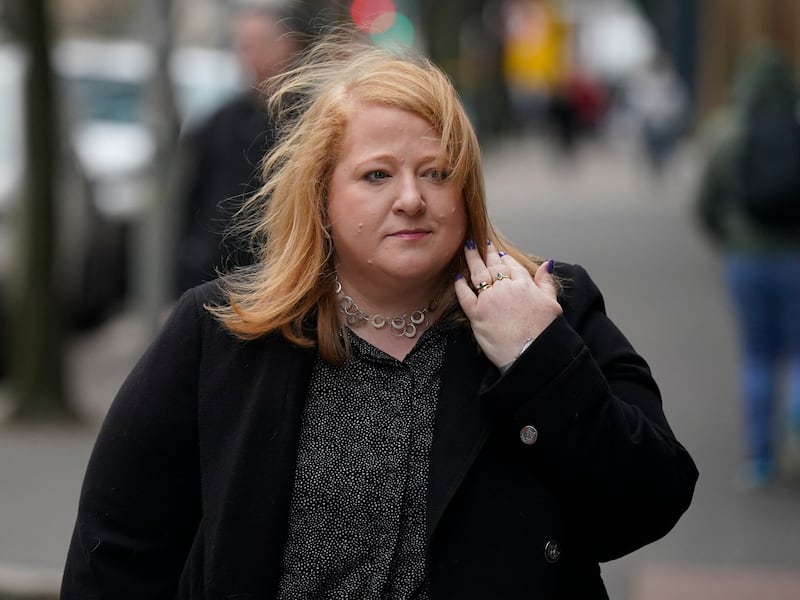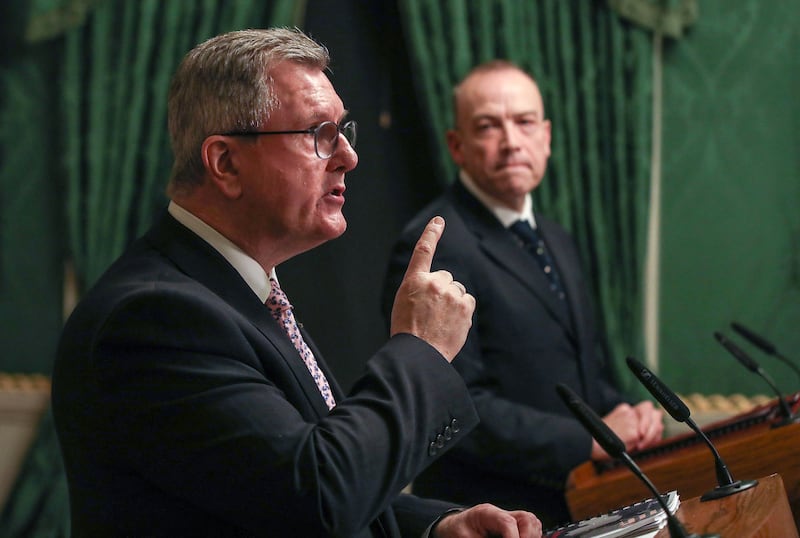Saturday, February 3rd, 2024. In years to come, much will be made of the significance of this day.
It says much about the stop-start nature of politics in Northern Ireland that the restoration of the political institutions – the Assembly and the Executive set up in 1998 as a result of the Belfast Agreement – is not where history is being made.
Most people in Northern Ireland would tell you they are glad to see Stormont up and running again, but it has been only four years since the last time it was resurrected. The depressing statistic is that since the formation of that first Assembly, it has been in limbo for longer than it has been operational.
It is easy to imagine the professors of the future speeding past this two-year hiatus in their lectures, perhaps explaining it only to make a wider point about the catastrophic impact of Brexit on the delicate political balance in Northern Ireland. Those professors might teach about how the United Kingdom’s departure from the European Union reawakened and reinvigorated the conversation around a united Ireland and how it pushed the topic into mainstream politics, and how this all took place against a backdrop of a changing society.
If 50 or 100 years hence, their students note down today’s date, it is because it marks a turning point: the first time in the North’s history that a nationalist, not a unionist, has been at the head of government.
To turn to the history books again, this is significant because this was never supposed to happen. The “boast” of the first prime minister of Northern Ireland, James Craig, was that “we are a Protestant parliament and Protestant state”. This was a status quo that was preserved by discrimination and gerrymandering until it all went up in the conflagration that was the Troubles. We are still living with the consequences.
Parliament Buildings, Craig’s pride and joy, opened in 1932. He could simply never have envisaged the scenario whereby one day unionists would no longer be in the majority and instead, a Sinn Féin first minister would take what he saw as their place.
A united Ireland is “within touching distance”, as Sinn Féin leader Mary Lou McDonald put it this week. James Craig will turn quietly in his marble tomb only a few hundred yards from Parliament Buildings
Northern Ireland is, of course, much changed since those days, and even since 1998, when that first powersharing government was led by Ulster Unionist Party (UUP) leader David Trimble as first minister and Seamus Mallon of the Social Democratic and Labour Party (SDLP) as deputy first minister.
Now Sinn Féin is knocking at the door of the “hat-trick”, as Jon Tonge, professor of politics at the University of Liverpool puts it: it is the largest party at local council level, at Assembly level and at Westminster, where an election is expected this year. The tally of seats in the House of Commons between the North’s two main parties stands at seven to eight to the Democratic Unionist Party (DUP).
The 2021 census showed that, for the first time, there were more people from a Catholic background than a Protestant one in Northern Ireland, and the number of people who do not regard themselves as having any religion is growing; politically, roughly 20 per cent of votes now go to parties that identify neither as unionist nor nationalist but as other, as demonstrated above all by the recent success of Alliance.

Today’s milestone in reality came two years ago, immediately after the May 2022 election, when Sinn Féin returned as the largest party with the largest number of seats, entitling its vice-president and leader in the North, Michelle O’Neill, to the position of first minister.
This is a joint office, with, in practice, the same powers as the deputy first minister; one cannot govern without the other.
Yet this is a place where names – and symbols – matter. When O’Neill takes to her feet on Saturday and speaks in the chamber as first minister, the moment comes wrapped up in 100 years of symbolism.
Advocates of a united Ireland, not least Sinn Féin, will inevitably see it as another step along that path.
It is “within touching distance”, as Sinn Féin leader Mary Lou McDonald put it this week. James Craig will turn quietly in his marble tomb only a few hundred yards from Parliament Buildings.
[ History suggests Mary Lou McDonald’s comments on unity are wildly exaggeratedOpens in new window ]
From Sinn Féin’s point of view, what will make the moment all the sweeter is that it is viewed, at least in part, as coming at the DUP’s own hand.
If Brexit was the initial act of self-harm, then the two years of stalemate as the health service imploded, public services collapsed and Northern Ireland was brought to a virtual standstill by strike action did nothing to make the case that the place was working.
Lawyer and unionist commentator Sarah Creighton wrote in the Guardian this week that “there will be no champagne corks popped across Northern Ireland ... Most, I expect, will get on with their lives with weary resignation.”
Rather than the DUP “celebrating this breakthrough, it should be apologising for the lives it has ruined.”
In a hotel function room in the early hours of Tuesday morning, DUP leader Jeffrey Donaldson announced to the few who were still up that, depending on the UK government holding up its end of the deal, the party would end its boycott of the Stormont institutions and go back in.
It was altogether underwhelming, the final act in a tragedy that had already dragged on far too long. There was no sense of a big breakthrough, more that the DUP had finally bowed to the inevitable.
“They simply ran out of road,” was the line repeated over and over in conversations this week.

Donaldson had been preparing the ground for a return for some time, as demonstrated by his party conference speech in October, when he outlined his support for devolution.
In the end, what it came down to was political courage, the conviction to face down his opponents – from within and without – and persuade them a return to Stormont was the only viable option.
The key here was winning the support of Edwin Poots, briefly DUP leader and one of the party’s “big beasts”. His backing for Donaldson last week was the clincher, giving the leader a majority among the party’s 12-person officer team.
Ever the pragmatist, Poots described the deal reached this week with the UK government as a “significant milestone” but there was “further work to be done.
“We’re not settled at this as a finish; it gives us enough to move on from the tactic that was utilised to force change, which wasn’t forthcoming, but that tactic has come to an end for now and we’ll be working with His Majesty’s Government on other issues,” he said.
That tactic has done its work. The DUP’s boycott did secure changes to post-Brexit trading arrangements, as evidenced by the replacement of the Northern Ireland protocol with the Windsor framework and, though a trade border still remains in the Irish Sea, they have succeeded with this new agreement in removing most checks on goods moving from Britain to Northern Ireland.
Whether it has secured the place of Northern Ireland within the UK remains to be seen, regardless of all 80 pages of reassurance published by the UK government under the title Safeguarding the Union. That this should be deemed necessary belies an underlying fear over the vulnerability of that union.
From his point of view, Donaldson has played this well, both in terms of the concessions he has won from the UK government and, a few dissenters aside, in managing to keep his party with him as they return to Stormont.
Others would question whether this two-year hiatus was necessary in the first place, and for all the DUP would argue it has gained, there is much that has been lost.
“We’re seeing people in A&E for actual days now ... years ago, if you breached the four-hour wait, everybody was horrified. Now it’s just firefighting the whole time,” said social worker and union representative Deborah Yapicioz ahead of mass strike action last month.
Although the problems with the health service started long before the DUP walked out of the Executive, this is a snapshot of the extent of the challenges incoming ministers are facing.
For all the apparent permanence of that big building looking down from the top of the hill, after every collapse, the principles of powersharing, and democracy itself, are further eroded.
In a political vacuum, alternatives emerge; be they violent – as Northern Ireland knows to its cost – or constitutional: direct rule from London, joint authority or a united Ireland.
Stormont was and is the compromise, and the only way for unionism to keep Northern Ireland in the union for the long term is the very opposite of the last two years – to make it work.
Of all the symbolism that will swirl around Michelle O’Neill as she takes office as first minister, it signifies above all that politics in Northern Ireland is being played on a new pitch.
If the conversation of the past 10 years has been Brexit, constitutional change will be that of the next decade.
- Sign up for push alerts and have the best news, analysis and comment delivered directly to your phone
- Find The Irish Times on WhatsApp and stay up to date
- Our In The News podcast is now published daily – Find the latest episode here












